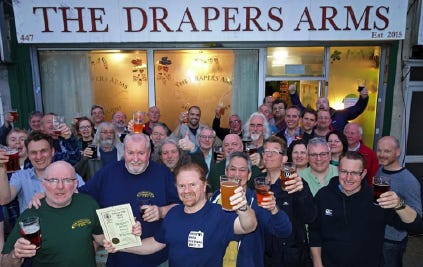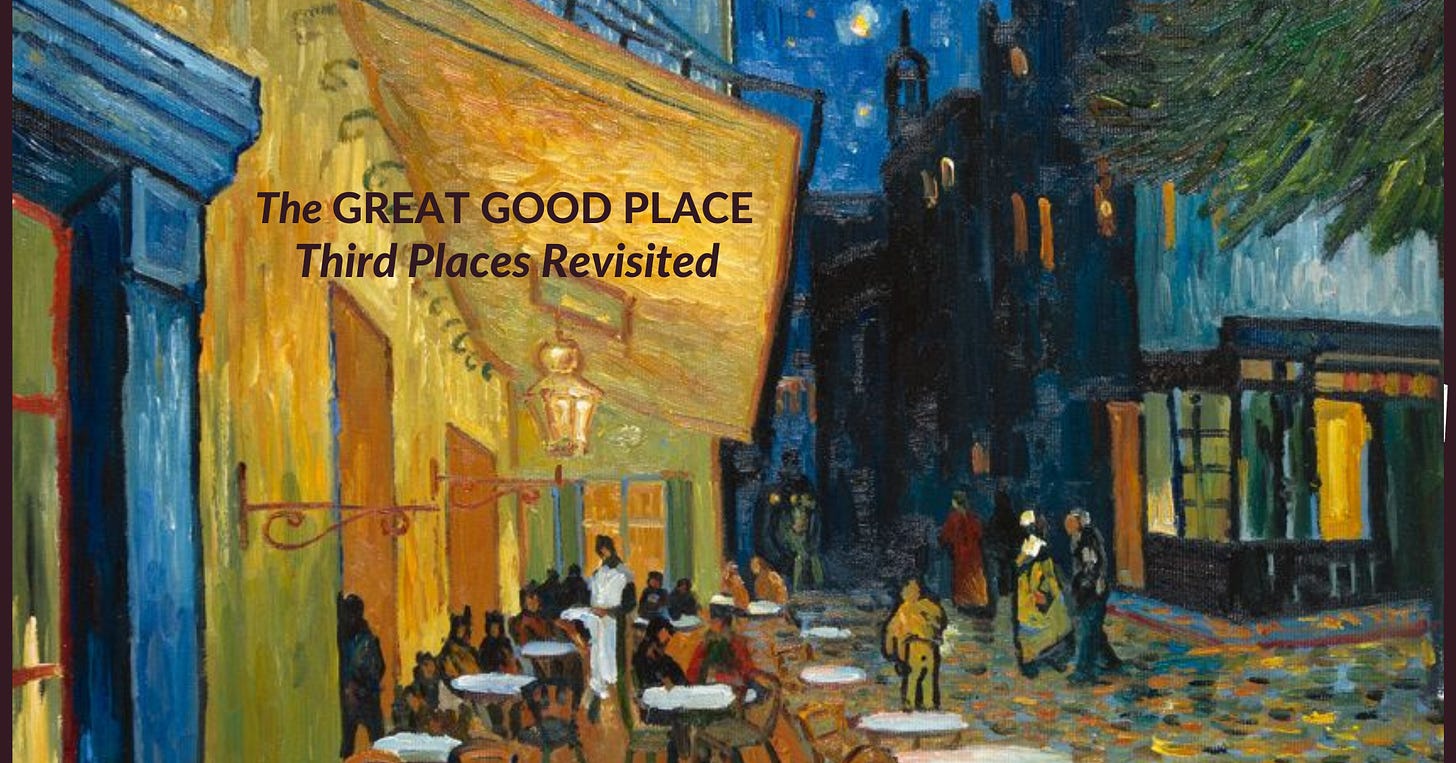Friday Triad: 3 new business models for third places
Social businesses worth a look
When I started working on the new book, the drumbeat was that third places had disappeared, it was terrible, but what could anyone do except spend their time on Facebook or writing laments on Reddit?
It wasn’t long till I found out, almost always from people living somewhere other than the United States, that third places still exist and thrive and reinvent themselves. Today I’d like to highlight two of them, places I haven’t visited yet but recommended by colleagues, both providing food for thought for any of us who are wondering how to create or nurture a third place.
Drapers Arms, Bristol
I heard about the Drapers Arms from Susannah Marriott at John Yorke Story when I mentioned that I was writing about third places and sent her a link to this piece from the Guardian1 (which my friend Kathy Giuffre in Italy sent along - just to show you how these ideas are circulating) about a proposed new Britain version of the TV show Cheers.
Susannah wrote:
I was at the pub last night. It’s as small as a living room in a two-up two-down house and so cosy - you have no choice but to budge up on the benches and chat to everyone. You’d love it: https://www.thedrapersarms.co.uk/. literally the space that used to be a Draper’s shop with some benches and tables plonked down. Probably cost about £100 to convert…. Sometimes a Welsh choir turns up on the way back home after a rugby match and sings while sipping their pints. Magic!
Envious already?
The Drapers Arms is really interesting as a business model. (“Beer and conversation – is that it? A lot of different beers and a lot of different conversations but, in a nutshell, yes.”) Compare it to a gastro-pub or American bar-restaurant, which require a full kitchen and quite a lot of staff, and often seem to be music venues as well. This means huge upfront investment, probably putting your own house and assets on the line for a bank loan, and high operating cost, too. It’s hard to create a relaxed, social atmosphere when you’re under that kind of pressure.
The Fish Shop, Dublin
A few days later, I was talking about these business challenges with architect and planner Stephen Coyle, who has worked in Europe and Africa. We compared notes about start-up food and drink businesses. Steve said that he’d been thinking about minimal requirements for a new business. In Africa, he said, it would be an orange crate and an umbrella. Here in the US, he thought food trucks were the starting point. Indeed, food trucks are becoming much more common - even in a small town like Great Barrington.2 Some places are only doing take-out (no good for a third place) or pop-ups.
My concern is that we need year-round places where people can meet regularly, as we can in bars and coffee shops. Steve mentioned a pub he’d visited in Dublin that he thought was interesting because although they serve food, it’s a single thing: fish and chips. Old-fashioned diners and cafes handled this in a different way: they’d have a special every day and a limited menu. In both cases, they kept costs, and waste, to a minimum.
I’d love to hear from those with experience owning, running, or working in restaurants. Can they be third places or is the financial pressure just too great today?
Yemeni coffee shops
One question that comes up a lot these days is whether there are third places to hang out in the evening other than bars and pubs. We’ve become convinced that coffee and tea are morning shots only, which leaves people who don’t want to drink alcohol sometimes feeling like there’s no place for them. And a lot of bars don’t have much of a third-place, conversational atmosphere anyhow.
When I was a teenager in the Silicon Valley, we used to hang out at all hours at the Good Earth restaurant in Cupertino, drinking its spicy house-blend tea. I think a strong peppermint tea would do equally well. But coffee house culture started in the Middle East and I’m glad to say that it’s having a renaissance thanks to Muslim entrepreneurs. I see a lot of opportunity. Here’s some recent news:
What the rising popularity of Yemeni coffee shops says about third places
Posted by Wisconsin Muslim Journal | Oct 29, 2024
The most popular spot on a late Friday night in a pocket of Manhattan’s West Village isn’t a trendy bar or a Michelin-starred restaurant but a Yemeni coffee house chain strictly serving coffee, tea and pastries.
Nineteen Qahwah House locations are open across seven states, with more under construction and expected to open this year. Another chain, Haraz, opened this month in the pricey SoHo neighborhood in Manhattan, with at least six more in the region planned in the next two years. Times Square will be home to two other chains, MOKAFÉ and Qamaria Yemeni Coffee Co.
The rapid expansion of these shops underscores the demand for late-night social spots for not only young Muslims and Middle Easterners, but also younger people who are looking for a non-digital third space where they can hang out without alcohol or having to yell over loud music.
They don’t have many other options. Malls, a traditional third place for young people, are growing more and more unpopular. Chains like Starbucks have become more like take-out counters. Alcohol-free lifestyles are growing even for those outside of the Muslim faith, which many practicing the religion already take part in.
So for many young people in urban areas, especially those from immigrant communities looking for a way to connect to their cultures, it’s a great option.
In New York “people like to go out clubbing,” Bhavishya Banda, a strategy consultant, said one late night at Qahwah House. “Personally, I don’t find enjoyment in that. But I want to go out at night.”
Third spaces are not a new concept. Sober bars popping up across the country aim to build a sense of community and social connections. But Yemeni coffee houses have taken up both those trends and boomed.
Where did Yemeni coffee shops come from?
In the Middle East, coffee isn’t a grab-and-go drink used to wake up with, but a social exchange. While coffee beans originated in Ethiopia, the earliest evidence of cultivation appeared in Yemen through trading across the Red Sea.
The practice followed into the early 20th century and across the world, when the first wave of Middle Eastern immigrants came to Detroit to work in the auto industry or shipping yards, Howell said. Most immigrants were men who migrated alone, so one of the first institutions they created were coffee houses where they would gather to socialize, share news about their home country, and even write letters back home. Many of the initial mosques in the area were originally established in the backs of the coffee houses.
Here’s the Guardian article: “Not just desperate but cruel! Making a British Cheers is the stupidest TV idea yet.” I don’t agree, but that’s a subject for another day.







